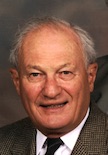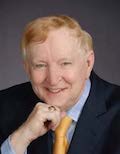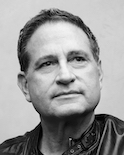The Orthomolecular Medicine Hall of Fame was established in 2004 by the International Society for Orthomolecular Medicine to honour the pioneers and leaders in Orthomolecular Medicine. Today, there are eighty people in the Hall of Fame – physicians, researchers, professors and advocates – each having made a significant contribution to the foundation and growth of Orthomolecular Medicine around the world. These remarkable people make up the rich history and broad range of interest and experience in Orthomolecular Medicine.
Every year, members of the Hall of Fame nominate others whom they consider worthy of inclusion. The submissions are reviewed and voted on by Hall of Fame members; those with the most votes are chosen to be inducted at the following year’s ceremony, which takes place at the Annual Orthomolecular Medicine Today Conference.
 Derrick Lonsdale, MD
Derrick Lonsdale, MD
b. 1924, Lancashire, England
Along with his older brother, Derrick attended The Leys School in Cambridge. With the onset of World War II the school was forced to move to Scotland. While exploring the Scottish Highlands, Derrick discovered his love of nature and it was at The Leys that he decided to pursue medicine. Upon graduation he entered St. Bartholomew’s Hospital Medical School in London but due to the Blitz he was relocated to Queen’s College in Cambridge.
Upon graduation in 1948, Derrick took a residency at St. Bartholomew Hospital. He was required to do National Service and joined the Royal Air Force, where he was assigned to a base in Germany. There he met the love of his life, Adele Brew, a nurse.
After Germany, Derrick decided to specialize in Paediatrics at a children’s hospital in Sydenham. He continued to court Adele and they were married in 1951.
During this time Derrick worked in several local practices until he became a partner in Sleaford. Three of their children were born in this time – David in 1953, Michael in 1954, and Susan in 1957. Just after Susan’s birth, they began a new adventure and moved to Canada, near London, Ontario, where Derrick worked for the Royal Canadian Air Force.
Four years later he was invited to do a paediatric residency at the Cleveland Clinic Foundation. Daughter Sally was born in 1961, and Derrick later became Cleveland Clinic Foundation Staff Number 52, upon finishing residency in 1962 .
While on staff, Derrick received patients from all over the United States and was thrilled every day by scientific challenges. The social life among the Cleveland Clinic Family was a joy. A good pianist, Derrick played in a hospital band called the Arrhythmias, which performed at several clinic functions.
Derrick became increasingly interested in the biochemistry of medicine and healing and was drawn to Preventive Medicine. In 1982, he joined Dr. James Frackelton in the Preventive Medicine Group and worked there until his retirement at age 89. His patients taught him that nutrition was the most important thing that we can do for ourselves in maintaining our own health and that many conditions can be controlled by a good diet with vitamin and mineral supplementation.
His books include: A Nutritionist’s Guide to the Clinical Use of Vitamin B1 (1987); Why I Left Orthodox Medicine: Healing for the 21st Century (1994); A Nutritional Approach to a Revised Model for Medicine: Is Modern Medicine Helping You? (2013); Thiamine Deficiency Disease, Dysautonomia, and High Calorie Malnutrition (2017).
Derrick presented at the Orthomolecular Medicine Today Conference in 1995 and 2001. His articles are published and cited in the Journal of Orthomolecular Medicine.
Looking back on his career choices, Derrick writes, “I have no regrets and have learned repeatedly that the human body heals itself if it has the needed energy. This can only be done by the art and science that surrounds the principles of good nutrition.”
 Richard Albert Passwater
Richard Albert Passwater
b.1937 Delaware, USA
Although his early focus was on analytical chemistry and spectrophotoluminescence he began researching selenium and other antioxidants in 1959. In 1962, he discovered antioxidant synergism (US patent 6,090,414), and it is believed that reports of his research in 1970-71 in the lay press introduced the public to the words “free radical”, “antioxidant”, and “selenium”.
He was Director, Research Analytics Laboratories at Allied Chemical Corporation (Marcus Hook, PA), Director, Applications Research Laboratory at Baxter-Travenol Laboratories (Silver Spring, MD), Vice President of Research for the American Gerontological Research Laboratories Division of Life Science Labs (Rockville, MD), Director of the Solgar Nutritional Research Center, and Vice President of Research and Development for Solgar Vitamin & Herb Company. Additionally, in the early 1970s, he was the first nutrition advisor to a National Football League team, and was also a nutrition advisor to the professional boxer and humanitarian, Muhammad Ali.
In 1975, his first book for the general public, Super-Nutrition: Megavitamin Revolution, was a #4 national best seller, and has been credited with legitimizing megavitamin therapy. More than 45 books, over 600 articles, and over 7,000 radio shows on nutrition followed. He served as WholeFoods Magazine’s science editor for 36 years, and continues to contribute to its “Vitamin Connection” column which he created. He has also been on the editorial board of the Journal of Applied Nutrition, and has been cited 39 times in the Journal of Orthomolecular Medicine.
He received the nutrition industry’s Achievement Award (1989), National Nutrition Foods Association’s Presidents Award (1999), James Lind Scientific Achievement Award (2004), John Peter Zenger Free Press Award for writing (2004), and was twice honored by the Committee for World Health (1978 & 1980). He also was voted Citizen of the Year by his community (Ocean Pines, Maryland, 1987), and was voted into the Delmarva Firefighter’s Hall of Fame (1993). He considers his continuing marriage to Barbara Gayhart since 1964 to be the best thing that ever happened to him. Two children, two grandchildren, and two great-grandchildren followed.
 Neil Riordan, PhD
Neil Riordan, PhD
b.1958
Neil Riordan earned his Bachelor of Science summa cum laude at Wichita State University, and received his Master’s degree at the University of Nebraska Medical Center. He went on to earn a PhD in Health Sciences at the Medical University of the Americas.
Dr. Riordan is founder, chairman, and chief science officer of the Stem Cell Institute in Panama, which specializes in the treatment of human diseases and conditions with umbilical cord tissue-derived mesenchymal stem cells. He is co-founder and chief science officer of the Riordan Medical Institute (RMI) in Southlake, Texas, where orthopaedic conditions are treated with autologous bone marrow-derived stem cells combined with amniotic tissue products.
Neil is also the founder of Aidan Products, which provides health care professionals with high-quality nutraceuticals, and of Signature Biologics, which manufactures human placental derived innovative products to support and improve the natural healing processes of the body.
Neil has published more than 70 scientific articles in international peer-reviewed journals and coauthored more than 20 articles in the Journal of Orthomolecular Medicine. He and his colleagues have published articles on the use of stem cells for multiple sclerosis, spinal cord injury, heart failure, rheumatoid arthritis, Duchenne muscular dystrophy, and autism, among others.
For the discovery of mesenchymal-like stem cells in menstrual blood, his team was honored with the “Medical Article of the Year Award” from Biomed Central.


